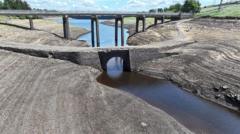Is England Facing Widespread Drought Conditions?

Understanding the Impacts of Drought in England: A Comprehensive Overview
The recent announcements regarding drought conditions in England highlight a pressing environmental concern that affects not only water supply but also agriculture, ecosystems, and daily life. As the National Drought Group prepares to declare more regions in drought status, it’s crucial to understand the implications of these declarations and the factors contributing to increased drought frequencies. This article delves into the causes of drought, its impact on various sectors, and what the future may hold for England’s water resources.
What is Drought and How is it Defined?
Drought is not a one-size-fits-all term; its definition can vary significantly based on geographical contexts, seasons, and weather patterns. In England, drought is typically characterized by:
- Prolonged periods of low rainfall.
- Reduced reservoir levels.
- Low river flows.
- Dry soil conditions.
While England lacks a singular, universally accepted definition of drought, the Environment Agency (EA) utilizes these indicators to assess the situation. In contrast, Scotland monitors "water scarcity" without officially declaring droughts.
Natural Weather Patterns vs. Climate Change
Droughts are primarily caused by natural weather patterns, including changes in atmospheric conditions and variations in precipitation. However, climate change is significantly exacerbating the situation. Key points to consider include:
- Rising global temperatures lead to increased evaporation rates, reducing soil moisture.
- Growing populations put additional pressure on water resources, leading to unsustainable usage.
- Climate change is expected to cause more frequent and intense heatwaves, further depleting water supplies.
The Current Drought Situation in England
As of recent reports, several regions in England are expected to join the ranks of Yorkshire and the North West in an official drought status. This follows a notably dry spring—the driest in over a century—and subsequent heatwaves that have intensified the issue. Richard Thompson, deputy director of water resources at the EA, has indicated that many areas could face drought conditions if they receive only 80% of their long-term average rainfall.
Regional Differences in Drought Status
It’s important to note that while some areas, such as parts of Kent and Sussex, have already implemented hosepipe bans, they may not officially be classified as in drought status. The distinction between these terms can create confusion for residents seeking to understand the severity of the water crisis in their regions.
Impacts of Drought on Various Sectors
The implications of drought extend far beyond just water conservation efforts. Several sectors are significantly affected:
Agriculture
Agriculture is often the most visible sector impacted by drought, with consequences that ripple through the economy. Key impacts include:
- Reduced crop yields due to inadequate water supply.
- Increased costs for farmers as they seek alternative water sources.
- Food price inflation as supply decreases.
Ecosystems and Wildlife
Drought can also have devastating effects on local ecosystems. As water levels drop:
- Fish and aquatic life suffer from reduced habitats.
- Terrestrial wildlife may struggle to find water sources.
- Plant life may experience stress, leading to reduced biodiversity.
Water Supply Management
Water companies play a crucial role in managing resources during drought conditions. Their strategies may involve:
- Implementing hosepipe bans to conserve water.
- Encouraging residents to adopt water-saving measures.
- Investing in infrastructure to improve water storage and distribution.
Looking Ahead: The Future of Water Resources in England
The EA has warned of a potential shortfall in water supplies of up to six billion liters a day by 2055 if no significant action is taken. With rising temperatures and a growing population, the urgency for sustainable water management practices has never been greater. Possible solutions include:
- Investing in water recycling and conservation technology.
- Enhancing infrastructure to better capture and store rainwater.
- Public education campaigns on the importance of water conservation.
The Role of Climate Policy
Addressing the root causes of climate change is also essential. Governments and organizations must work together to create policies that promote sustainability and reduce carbon footprints. This could involve:
- Transitioning to renewable energy sources.
- Implementing stricter regulations on water usage in industries.
- Encouraging sustainable agricultural practices.
Conclusion
The prospect of further drought declarations in England serves as a reminder of the urgent need for comprehensive water management strategies. As climate change exacerbates weather patterns, the responsibility falls on both individuals and governments to adapt and take action. By understanding the complexities of drought, we can better prepare for the future and ensure sustainable resources for generations to come.
What steps do you think should be taken to combat the growing water crisis in England? #DroughtAwareness #WaterConservation #ClimateAction
FAQs
What factors contribute to drought conditions in England?
Climate change, prolonged periods of low rainfall, increased evaporation rates, and growing water usage contribute to drought conditions in England.
How does drought affect agriculture?
Drought leads to reduced crop yields, increased production costs, and potential food price inflation as supply diminishes.
What is the role of the Environment Agency in managing drought?
The Environment Agency monitors water levels, river flows, and soil conditions to declare drought statuses and implement water management strategies.
Are hosepipe bans always implemented during drought conditions?
No, hosepipe bans are not automatically imposed during drought declarations, although they often follow to help conserve water resources.
What can individuals do to conserve water during droughts?
Individuals can conserve water by fixing leaks, using water-saving fixtures, and adopting mindful water usage practices, such as shorter showers and efficient gardening techniques.
Published: 2025-07-15 00:27:12 | Category: technology



